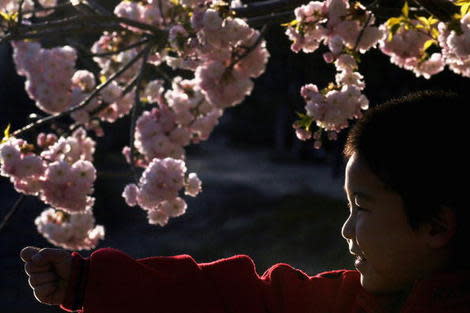Lunar New Year: Serving the Water Dragon
Happy 4709. Sun nien fai lok (Cantonese) or Xin Nian Kuai (Mandarin).
By now, casual observers know the Dragon ushers in this Lunar New Year. In general, the dragon in Chinese mythology is a far more benevolent and beneficial creature than its Western fire-breathing counterpart. The last time the creature ruled the zodiac, though, it wasn't just a Golden Dragon (an elemental phenomenon that occurs every 60 years), but an Angry Dragon. That means all animals had to watch out and avoid touchy scenarios.
This time around, the much more amenable Water Dragon takes the astrological reign. According to the site Lunar New Year Houston, "This year favors the art of negotiation, progressive ideas with an eye to reinforcement of foundations for all we plan to build for the future... Given the challenging conflation of current events, both natural and man-made, it is truly fortuitous that the Year of the Water Dragon is heralded for its serene, visionary intelligence. It is a Dragon Year that celebrates a balance of left-brain logic with right-brain creativity."
Even so, New Year celebrants take no chances. The symbolic decorations, food trays, and all sorts of rituals/superstitions (which can vary depending on the region) all work in tandem to keep evil spirits at bay and get fortune flowing.
FOODS
Nian'gao
Eating well is a must in Chinese culture, but depending on the religious affiliation, a New Year's meal can be a meatless one. One common concept though is to eat sweet so that life, at least in the next 12 months, will be sweet. Sticky rice flour is mixed with sugar and water and steamed to make the treat nian'gao - a tasty throwback in an increasingly gluten-free world. The word gao also translates to ascension, so eating the sweet rice cake will help one rise up in the coming year. New Year celebrations include food that connotes prosperity, wealth and unity.
Prosperity tray
Let the puns begin. Thanks to its tonal nature, the Chinese language lends itself to a lot of homonym play. Sharing prosperity means passing out sweets, such as red dates, melon seeds and fruits. As the Chinese word for eight rhymes with getting riches, the tray is octagonal. Traditionally, that tray holds items like candied ginger, lotus root, lotus seeds, young coconut, melon and kumquat. While not on this tray, both black and red watermelon seeds make an appearance this time of year.
Pomelos
From birthday dinners to ancestral offerings, homonyms again determine what dishes are served. Meaning extends even to how food looks: The roundness of mandarin oranges and dumplings symbolizes unity (coming full circle). Pomelos and mandarin oranges stack up for a fragrant fruit display. Mandarin oranges suggest perfection in their roundness and represent longevity as well. The homonym for pomelos, which are similar to grapefruit, is "to have."
Things to pass out
Lai see
Talk about a shrinking middle class: The tradition of passing out crisp cash falls on married couples, and what with the state of wedlock at a decline these days, the burden's falling on fewer and few shoulders. Children and singled people are eligible for the "lai see" or "hungbao," the red envelopes stuffed with money. While the money should be given in amounts divisible by two (to symbolize double greetings and appreciation), even single $1 bills can add up to a nice booty.
New year cards
New Year cards are actually an adoption of the western tradition of passing paper greetings. While anime has added cartoonish wide-eyed kids on the cards, the more standard symbols include a carp, standing in for beauty and wealth; the lion, actually a rendition of the extravagant costumes used in the lion dances; and of course the gold dragon, always an imperial and popular icon.
Ancestral offerings
Incense
New Year is a time to honor the past. Incense, usually sandalwood, is burned either at home ancestral shrines, temples, or burial sites to pay respects to one's forebears.
Symbolic money
Besides burning incense, those paying respect to their forebears burn fake money. This ensures that they can live a comfortable afterlife.
Decorations
Fake firecrackers
Lighting Chinese firecrackers frightens off evil spirits, although setting them off in the living room probably violates a fire code. This decoration is almost as good as the real thing. The real stuff is used in parades, performances and at businesses where lion dancers visit to bring good luck.
Hui chun
Translated as "red couplets," these vertical paper scrolls refers to the four-character inscription, with typical greetings such as "May your spirits be at ease and prosperous," "Peace upon entering and exiting" or "May one get one's heart's desires/May one's handiwork be realized." The gold-embellished greetings can be intended for specific locales, like the kitchen or a door. Some households hang these paper greetings year-round for perpetual luck and to ward off monsters.
Blossoms

In China, the lunar new year actually signals the beginning of spring. With the season comes blossoms, and those symbolize life, growth and riches. If flowers bloom during the New Year festivities, that signals a particularly good year ahead. The most propitious would be a blooming peach blossom, since the peach symbolizes long life and a charm against evil. Peach blossom sprays used to be placed above building entrances to ward off evil spirits; these days, they're usually decorative household displays. Other favored flowers are the kumquat tree, the tiny orange fruit, narcissus and plum or cherry blossoms.